Related Research Articles

The Durham Coast Line is an approximately 39.5-mile (63.6 km) railway line running between Newcastle and Middlesbrough in North East England. Heavy rail passenger services, predominantly operated Northern Trains, and some freight services operate over the whole length of the line; it provides an important diversionary route at times when the East Coast Main Line is closed. Light rail services of the Tyne and Wear Metro's Green Line also operate over the same tracks between a junction just south of Sunderland station and Pelaw Junction.

Woking railway station is a major stop in Woking, England, on the South West Main Line used by many commuters. It is 24 miles 27 chains (39.2 km) down the line from London Waterloo. The station is managed by South Western Railway, who operate all trains serving it. Many South Western Railway services call at Woking, including:

East Boldon is a Tyne and Wear Metro station, serving the villages of Cleadon and East Boldon, South Tyneside in Tyne and Wear, England. It joined the network on 31 March 2002, following the opening of the extension from Pelaw to South Hylton.
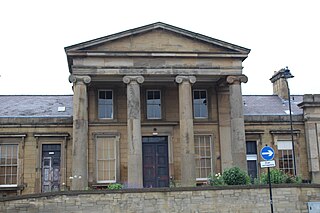
Monkwearmouth Railway Station is former station that served Monkwearmouth, Sunderland, England, from 1848 to 1967. It was built in 1848 to a design by Thomas Moore. and was once the main railway station in the city. The railway station closed in March 1967 and featured a restored booking office dating from the Edwardian period. The station was opened as a museum in 1973.

Rainford railway station is situated to the north of the village of Rainford, Merseyside, England. It is on the Kirkby branch line. The station, and all trains serving it, are operated by Northern Trains.
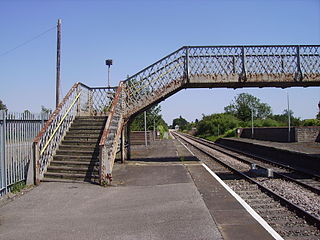
Brigg railway station serves the town of Brigg in North Lincolnshire, England. It was built by the Great Grimsby and Sheffield Junction Railway (GG&SJR) and opened on 1 November 1848. The GG&SJR subsequently became part of the Manchester, Sheffield and Lincolnshire Railway main line between Grimsby and Manchester Piccadilly. It is managed by Northern Trains, who also operate all passenger trains serving it. The station is unstaffed and the only buildings are the bus shelters standing on the platforms now for cover. In 2016, the footbridge was replaced, with the 1880s structure acquired by the Wensleydale Railway and installed at Leyburn.
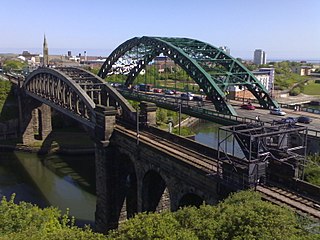
Monkwearmouth Railway Bridge is a railway bridge built in 1879, crossing the River Wear at Sunderland and Monkwearmouth. The bridge lies adjacent to and upstream of the Wearmouth Road Bridge.

Saxby railway station was a station serving the villages of Saxby and Freeby, Leicestershire. It was located between the two villages.
The Stanhope and Tyne Railway was an early British mineral railway, that ran from Stanhope in County Durham, to South Shields at the mouth of the River Tyne. The object was to convey limestone from Stanhope and coal from West Consett and elsewhere to the Tyne, and to local consumers. Passengers were later carried on parts of the line.

Little Steeping was a railway station on the East Lincolnshire Railway which served the hamlet of Little Steeping in Lincolnshire between 1848 and 1964. It became a junction station in June 1913 when the Kirkstead and Little Steeping Railway was opened to provide a more direct route to Skegness for East Midlands holidaymakers. Withdrawal of passenger services took place in 1961, followed by goods facilities in 1964. The line through the station remains in use as the Poacher Line, although the Kirkstead and Little Steeping Railway closed throughout on 5 October 1970.

Louth railway station was a station in Louth, Lincolnshire, England. It served as a junction for several different now closed lines which converged on the town.

Rolleston-on-Dove railway station is a disused railway station built to serve Rolleston on Dove in Staffordshire.

Dixon Fold railway station was built on the Manchester and Bolton Railway, between Clifton Junction railway station and Kearsley railway station, in Clifton near Pendlebury. It opened in 1841. Maps of the area from 1848 give it the name Clifton Station, which should not to be confused with the nearby Clifton railway station on Rake Lane, which opened in 1847. The station closed between 2 August 1926 and 7 March 1927, but was closed permanently on 18 May 1931. The station was demolished after closure.
Pendleton Bridge railway station was a railway station in Pendleton, Salford built on the Manchester and Bolton Railway, between Salford and Clifton Junction. The station was accessed from Station Street, just west of Broughton Road (A576). It was unusual in having a canal, the Manchester, Bolton & Bury Canal, running alongside the station behind the up (southbound) platform.
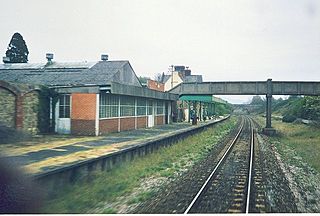
Seaton Junction is a closed railway station on the West of England Main Line from London Waterloo to Exeter. It was situated 3 miles west of Axminster and 7 miles east of Honiton. It was previously known as Colyton for Seaton and Colyton Junction.
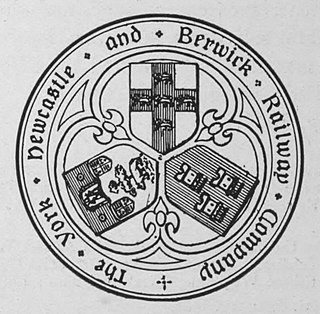
The York, Newcastle and Berwick Railway (YN&BR) was an English railway company formed in 1847 by the amalgamation of the York and Newcastle Railway and the Newcastle and Berwick Railway. Both companies were part of the group of business interests controlled by George Hudson, the so-called Railway King. In collaboration with the York and North Midland Railway and other lines he controlled, he planned that the YN&BR would form the major part of a continuous railway between London and Edinburgh. At this stage the London terminal was Euston Square and the route was through Normanton. This was the genesis of the East Coast Main Line, but much remained to be done before the present-day route was formed, and the London terminus was altered to King's Cross.
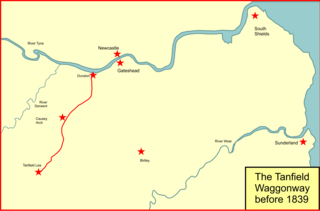
The Brandling Junction Railway was an early railway in County Durham, England. It took over the Tanfield Waggonway of 1725 that was built to bring coal from Tanfield to staiths on the River Tyne at Dunston. The Brandling Junction Railway itself opened in stages from 1839, running from Gateshead to Wearmouth and South Shields. Wearmouth was regarded at the time as the "Sunderland" terminal.

The Newcastle & Carlisle Railway (N&CR) was an English railway company formed in 1825 that built a line from Newcastle upon Tyne on Britain's east coast, to Carlisle, on the west coast. The railway began operating mineral trains in 1834 between Blaydon and Hexham, and passengers were carried for the first time the following year. The rest of the line opened in stages, completing a through route between Carlisle and Gateshead, south of the River Tyne in 1837. The directors repeatedly changed their intentions for the route at the eastern end of the line, but finally a line was opened from Scotswood to a Newcastle terminal in 1839. That line was extended twice, reaching Newcastle Central station in 1851.
High Shields railway station served the suburb of High Shields, South Tyneside, England, from 1842 to 1981 on the Brandling Junction Railway.
Oakwellgate railway station served the town of Gateshead, Tyne and Wear, England, from 1839 to 1844 by the Brandling Junction Railway.